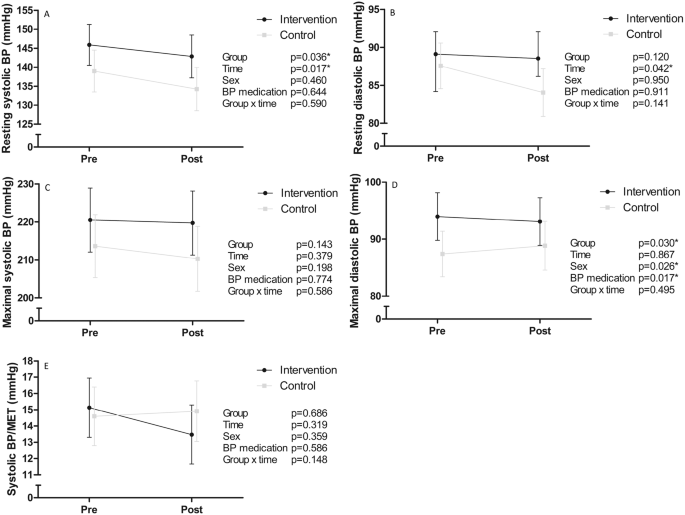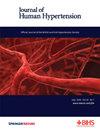Effects of reduced sedentary time on resting, exercise and post-exercise blood pressure in inactive adults with metabolic syndrome – a six-month exploratory RCT
IF 2.7
4区 医学
Q2 PERIPHERAL VASCULAR DISEASE
引用次数: 0
Abstract
Evidence on the long-term effects of reducing sedentary behaviour (SB) on blood pressure (BP) is scarce. Therefore, we performed a sub-analysis of the BP effects of a six-month intervention that aimed at reducing SB by 1 h/day and replacing it with non-exercise activities. Sixty-four physically inactive and sedentary adults with metabolic syndrome (58% female, 58 [SD 7] years, BP 143/88 [16/9] mmHg, SB 10 [1] h/day) were randomised into intervention (INT, n = 33) and control (CON, n = 31) groups. Resting BP and BP at each stage during and after a graded maximal bicycle ergometer test were measured before and after the intervention. SB, standing, moderate-to-vigorous physical activity (MVPA), and light physical activity (LPA) were measured in six-second intervals at baseline and during the whole six-month intervention using hip-worn accelerometers. The analyses were adjusted for BP medication status. The intervention resulted in a 40 min/day reduction in SB and concomitant 20 min/day increase in MVPA. Resting systolic BP was lower in the CON group before and after the intervention. No group x time interactions were observed in resting BP or BP during exercise at submaximal or maximal intensities, or during recovery. The changes in LPA and MVPA were inversely correlated with the changes in BP during light-to-moderate intensity exercise. An intervention that resulted in a 40 min/day reduction in SB for six months was not sufficient at influencing BP at rest, during or after exercise in adults with metabolic syndrome. However, successfully increasing LPA or MVPA might lower BP during light-to-moderate-intensity activities.


减少久坐时间对患有代谢综合征的非活动成人静息血压、运动血压和运动后血压的影响--一项为期六个月的探索性 RCT 研究。
有关减少久坐行为(SB)对血压(BP)的长期影响的证据很少。因此,我们对一项为期 6 个月的干预措施对血压的影响进行了子分析,该干预措施旨在减少每天 1 小时的久坐行为,并以非运动活动取而代之。我们将 64 名不运动和久坐不动的代谢综合征成人(58% 为女性,58 [SD 7] 岁,血压 143/88 [16/9] mmHg,SB 10 [1] h/天)随机分为干预组(INT,n = 33)和对照组(CON,n = 31)。干预前后分别测量静息血压以及分级最大自行车测力计测试期间和之后各阶段的血压。在基线和整个为期 6 个月的干预期间,使用髋部佩戴的加速度计以 6 秒钟的间隔测量 SB、站立、中到剧烈运动(MVPA)和轻度运动(LPA)。分析结果根据血压药物治疗情况进行了调整。干预后,SB 每天减少 40 分钟,MVPA 每天增加 20 分钟。在干预前后,CON 组的静息收缩压均较低。在静息血压、次最大强度或最大强度运动期间的血压以及恢复期间的血压方面,均未观察到组与时间的交互作用。LPA 和 MVPA 的变化与轻中强度运动时的血压变化成反比。对患有代谢综合征的成年人进行为期六个月的干预,每天减少 40 分钟的 SB 不足以影响休息时、运动中或运动后的血压。然而,成功增加 LPA 或 MVPA 可能会降低轻中强度活动时的血压。
本文章由计算机程序翻译,如有差异,请以英文原文为准。
求助全文
约1分钟内获得全文
求助全文
来源期刊

Journal of Human Hypertension
医学-外周血管病
CiteScore
5.20
自引率
3.70%
发文量
126
审稿时长
6-12 weeks
期刊介绍:
Journal of Human Hypertension is published monthly and is of interest to health care professionals who deal with hypertension (specialists, internists, primary care physicians) and public health workers. We believe that our patients benefit from robust scientific data that are based on well conducted clinical trials. We also believe that basic sciences are the foundations on which we build our knowledge of clinical conditions and their management. Towards this end, although we are primarily a clinical based journal, we also welcome suitable basic sciences studies that promote our understanding of human hypertension.
The journal aims to perform the dual role of increasing knowledge in the field of high blood pressure as well as improving the standard of care of patients. The editors will consider for publication all suitable papers dealing directly or indirectly with clinical aspects of hypertension, including but not limited to epidemiology, pathophysiology, therapeutics and basic sciences involving human subjects or tissues. We also consider papers from all specialties such as ophthalmology, cardiology, nephrology, obstetrics and stroke medicine that deal with the various aspects of hypertension and its complications.
 求助内容:
求助内容: 应助结果提醒方式:
应助结果提醒方式:


